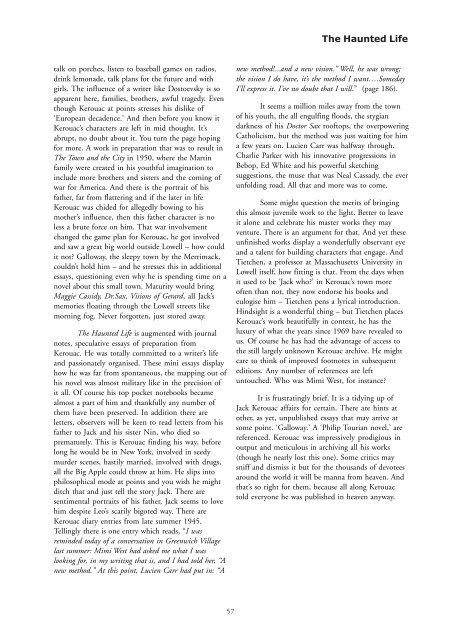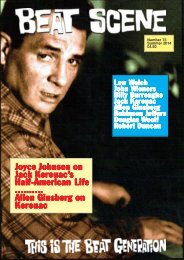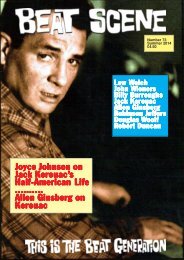You also want an ePaper? Increase the reach of your titles
YUMPU automatically turns print PDFs into web optimized ePapers that Google loves.
The Haunted Life<br />
talk on porches, listen to baseball games on radios,<br />
drink lemonade, talk plans for the future and with<br />
girls. The influence of a writer like Dostoevsky is so<br />
apparent here, families, brothers, awful tragedy. Even<br />
though Kerouac at points stresses his dislike of<br />
‘European decadence.’ And then before you know it<br />
Kerouac’s characters are left in mid thought. It’s<br />
abrupt, no doubt about it. You turn the page hoping<br />
for more. A work in preparation that was to result in<br />
The Town and the City in 1950, where the Martin<br />
family were created in his youthful imagination to<br />
include more brothers and sisters and the coming of<br />
war for America. And there is the portrait of his<br />
father, far from flattering and if the later in life<br />
Kerouac was chided for allegedly bowing to his<br />
mother’s influence, then this father character is no<br />
less a brute force on him. That war involvement<br />
changed the game plan for Kerouac, he got involved<br />
and saw a great big world outside Lowell – how could<br />
it not? Galloway, the sleepy town by the Merrimack,<br />
couldn’t hold him – and he stresses this in additional<br />
essays, questioning even why he is spending time on a<br />
novel about this small town. Maturity would bring<br />
Maggie Cassidy, Dr.Sax, Visions of Gerard, all Jack’s<br />
memories floating through the Lowell streets like<br />
morning fog. Never forgotten, just stored away.<br />
The Haunted Life is augmented with journal<br />
notes, speculative essays of preparation from<br />
Kerouac. He was totally committed to a writer’s life<br />
and passionately organised. These mini essays display<br />
how he was far from spontaneous, the mapping out of<br />
his novel was almost military like in the precision of<br />
it all. Of course his top pocket notebooks became<br />
almost a part of him and thankfully any number of<br />
them have been preserved. In addition there are<br />
letters, observers will be keen to read letters from his<br />
father to Jack and his sister Nin, who died so<br />
prematurely. This is Kerouac finding his way, before<br />
long he would be in New York, involved in seedy<br />
murder scenes, hastily married, involved with drugs,<br />
all the Big Apple could throw at him. He slips into<br />
philosophical mode at points and you wish he might<br />
ditch that and just tell the story Jack. There are<br />
sentimental portraits of his father, Jack seems to love<br />
him despite Leo’s scarily bigoted way. There are<br />
Kerouac diary entries from late summer 1945.<br />
Tellingly there is one entry which reads, “I was<br />
reminded today of a conversation in Greenwich Village<br />
last summer: Mimi West had asked me what I was<br />
looking for, in my writing that is, and I had told her, “A<br />
new method.” At this point, Lucien Carr had put in: “A<br />
new method!...and a new vision.” Well, he was wrong;<br />
the vision I do have, it’s the method I want….Someday<br />
I’ll express it. I’ve no doubt that I will.” (page 186).<br />
It seems a million miles away from the town<br />
of his youth, the all engulfing floods, the stygian<br />
darkness of his Doctor Sax rooftops, the overpowering<br />
Catholicism, but the method was just waiting for him<br />
a few years on. Lucien Carr was halfway through.<br />
Charlie Parker with his innovative progressions in<br />
Bebop, Ed White and his powerful sketching<br />
suggestions, the muse that was Neal Cassady, the ever<br />
unfolding road. All that and more was to come.<br />
Some might question the merits of bringing<br />
this almost juvenile work to the light. Better to leave<br />
it alone and celebrate his master works they may<br />
venture. There is an argument for that. And yet these<br />
unfinished works display a wonderfully observant eye<br />
and a talent for building characters that engage. And<br />
Tietchen, a professor at Massachusetts University in<br />
Lowell itself, how fitting is that. From the days when<br />
it used to be ‘Jack who?’ in Kerouac’s town more<br />
often than not, they now endorse his books and<br />
eulogise him – Tietchen pens a lyrical introduction.<br />
Hindsight is a wonderful thing – but Tietchen places<br />
Kerouac’s work beautifully in context, he has the<br />
luxury of what the years since 1969 have revealed to<br />
us. Of course he has had the advantage of access to<br />
the still largely unknown Kerouac archive. He might<br />
care to think of improved footnotes in subsequent<br />
editions. Any number of references are left<br />
untouched. Who was Mimi West, for instance?<br />
It is frustratingly brief. It is a tidying up of<br />
Jack Kerouac affairs for certain. There are hints at<br />
other, as yet, unpublished essays that may arrive at<br />
some point. ‘Galloway.’ A ‘Philip Tourian novel,’ are<br />
referenced. Kerouac was impressively prodigious in<br />
output and meticulous in archiving all his works<br />
(though he nearly lost this one). Some critics may<br />
sniff and dismiss it but for the thousands of devotees<br />
around the world it will be manna from heaven. And<br />
that’s so right for them, because all along Kerouac<br />
told everyone he was published in heaven anyway.<br />
57





